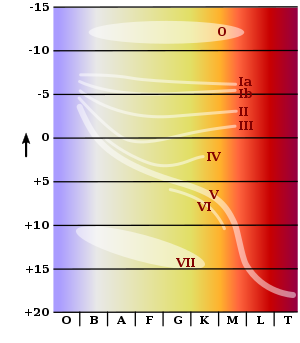Yellow giant
Yellow giants are massive stars of the spectral classes F and G and former main sequence stars .
Overview
Yellow giant stars emit their light mainly in the visible range and appear yellowish or yellow-white due to their surface temperatures . Yellow giants are cooler and less massive than comparable blue giants of similar size . In contrast to red giants , which only reach their size in the final stages of normal stellar evolution , when they expand many times over, yellow giants are about to die. Many of them are former blue giants or heavy main sequence stars that change into red giants or red supergiants with a yellow phase shortly before their end . The heaviest of them, from 6–8 M , end in a Type II supernova .
At 5000–7500 K , their surface temperature is comparable to that of the sun . Because of this, yellow giants are in the upper middle of the Hertzsprung-Russell diagram .
Examples
| Surname | Mass ( M / M ☉ ) | Radius ( R / R ☉ ) | Luminosity ( L / L ☉ ) |
|---|---|---|---|
| Arneb (α Lep A) | 9 | 75 | 13000 |
| Canopus (α Car) | 8th | 72 | 14800 |
| Capella Aa (α Aur Aa) | 3 | 10.8 | 75.8 |
| My Velorum A (μ Vel A) | 3 | 13 | 90.6 |
| Sham (α Sge A) | 4th | 20th | 340 |
| Wezen (δ CMa) | 17th | 200 | 50000 |
In general, yellow giants are relatively rare.
